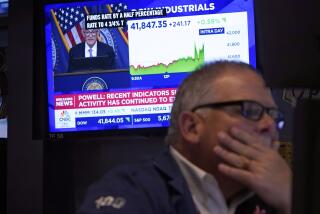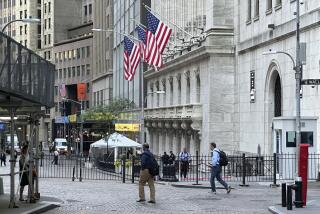Renewed Concerns Over Rate Hike by Fed Key 140-Point Blue-Chip Drop-Off
- Share via
Blue-chip stocks plunged Wednesday as long-term bond interest rates rose amid fresh fears that the economy’s strong growth would prompt an interest rate hike by the Federal Reserve Board.
The Dow Jones industrial average fell 139.67 points, or 1.93%, to close at 7,085.65, backing off from Tuesday’s record finish of 7,225.32.
It was the Dow’s steepest plunge since April 11 and erased most of the 154 points it had gained during back-to-back record-setting sessions in the two previous days, including a 143-point rise Monday.
Broader stock indicators also retreated, weighed down by another weak day in the bond market, where long-term interest rates continued to creep back toward worrisome levels.
The technology-laden Nasdaq market bucked the trend for much of the day but turned lower in the afternoon as the profit-taking intensified. The Nasdaq composite index fell 5.39 to 1,322.91 despite a strong performance from the computer networking sector.
“We had a three-week sabbatical (from interest rate and inflation worries), and now we’re going to take some of the hot air out of the balloon,” said Don Hays, director of investment strategy at Wheat First Butcher Singer of Richmond, Va.
Declining issues outnumbered advancers by nearly a 2-to-1 margin on the New York Stock Exchange in moderate trading.
The Standard & Poor’s 500-stock list fell 12.14 to 815.62, the NYSE composite index fell 5.82 to 424.95, and the American Stock Exchange composite index fell 0.01 to 570.50.
The bond market, which has been struggling this week to absorb a flood of new Treasury securities from the government’s quarterly refinancing, pulled back amid the latest signals from the Fed that while inflation has been mild, pricing pressures remain a worry.
With the majority of corporate earnings already reported for the quarter, investors had little choice but to focus on the bond market.
“When there are no earnings to move the market, the stock market and bond market move in tandem,” said Robert Froehlich, chief investment strategist at Kemper Funds.
In one of its periodic reports on regional economic conditions, the Fed reiterated the central bank’s long-standing concerns about tight labor markets and high levels of factory activity. Two Fed officials, meanwhile, echoed those themes in separate public appearances.
“Any little whisper along those lines is interpreted as a Fed that’s somewhat on the side of raising interest rates,” Hays said. “It’s the interpretation of the moment. Last week it was the opposite interpretation.”
The markets, which slid sharply in late March and April after the Fed raised a key lending rate to fight inflation, roared back to life last week amid indications that employment costs--which typically account for two-thirds of a product’s price--have remained under control.
Meanwhile Wednesday, the Labor Department reported that U.S. productivity increased at a 2% annual rate in the first quarter, the best in more than three years, but the improvement was not as strong as some had hoped. Improving productivity enables companies to raise wages without raising prices because workers are producing more with the same amount of work.
As the price of the benchmark 30-year Treasury bond fell, its yield surged to 6.96% from 6.89% Tuesday, after a disappointing auction of 10-year Treasury notes. The long-bond yield had been hovering above 7% for about a month before last week’s burst of enthusiasm.
With attention again focused on interest rates, analysts said the market’s next turn could quickly put the latest rally to the test.
“Certainly if rates keep rising and volatility keeps going along the way it has, that’s going to give investors cause to pause and think about what it is they’re doing,” said Charles White, managing director at Avatar Associates.
Among Wednesday’ highlights:
* Financial services issues, which enjoy a smaller profit margin when interest rates rise, were among the day’s biggest decliners. The Dow’s weakest issues included J.P. Morgan, down 3 1/2 to 101 3/8, and Travelers Group, down 2 1/2 at 54 3/8. In the banking sector, Chase Manhattan fell 2 7/8 to 95 3/8, Citicorp fell 3 1/4 to 113 3/4, BankAmerica fell 4 1/8 to 114 5/8, NationsBank dropped 3 1/4 to 59 5/8, and Wells Fargo skidded 9 1/4 to 267 1/4.
* Tech issues were among the day’s winners. Cisco Systems, which late Tuesday issued a profit report that met forecasts, rose 1 to 58 3/4; 3Com rose 1 3/8 to 37 1/8; and its proposed merger partner U.S. Robotics climbed 1 3/4 to 37 1/2.
Computer chip makers jumped after Merrill Lynch said demand for chips and PCs remains strong. Texas Instruments rose 1 7/8 to 93 7/8, Motorola gained 3/8 to 61 3/8.
But IBM fell 3 3/8 to 162 1/8.
* In more fallout from the Bre-X Minerals debacle, the Canadian mining company was delisted by the Toronto Stock Exchange and suspended by the Montreal and Alberta exchanges.
Overseas, London’s FTSE-100 still managed to end 18.2 points firmer to a record closing level of 4,537.5. In Tokyo, the 225-share Nikkei average fell 132.02 points to 20,048.90.
More to Read
Inside the business of entertainment
The Wide Shot brings you news, analysis and insights on everything from streaming wars to production — and what it all means for the future.
You may occasionally receive promotional content from the Los Angeles Times.










